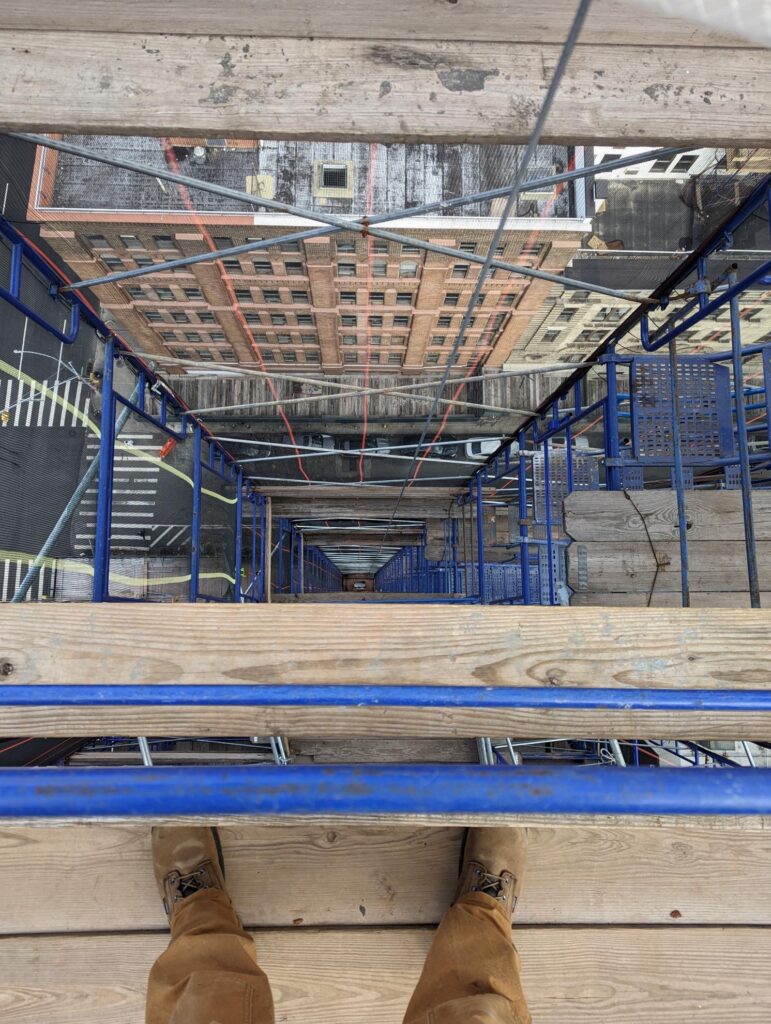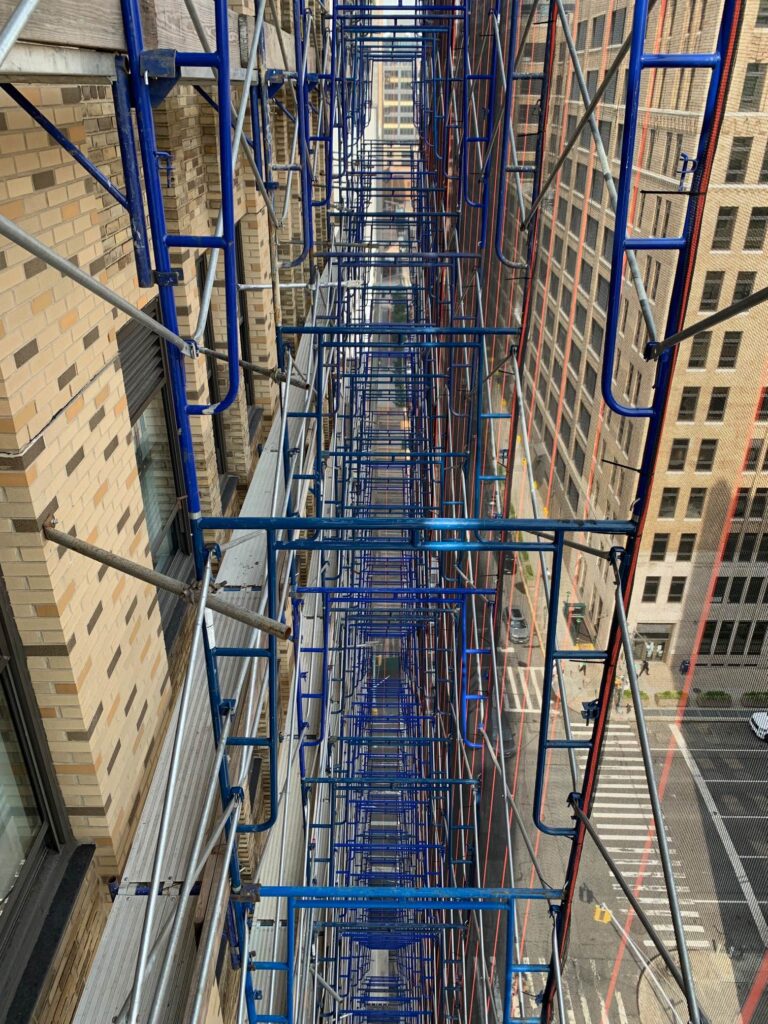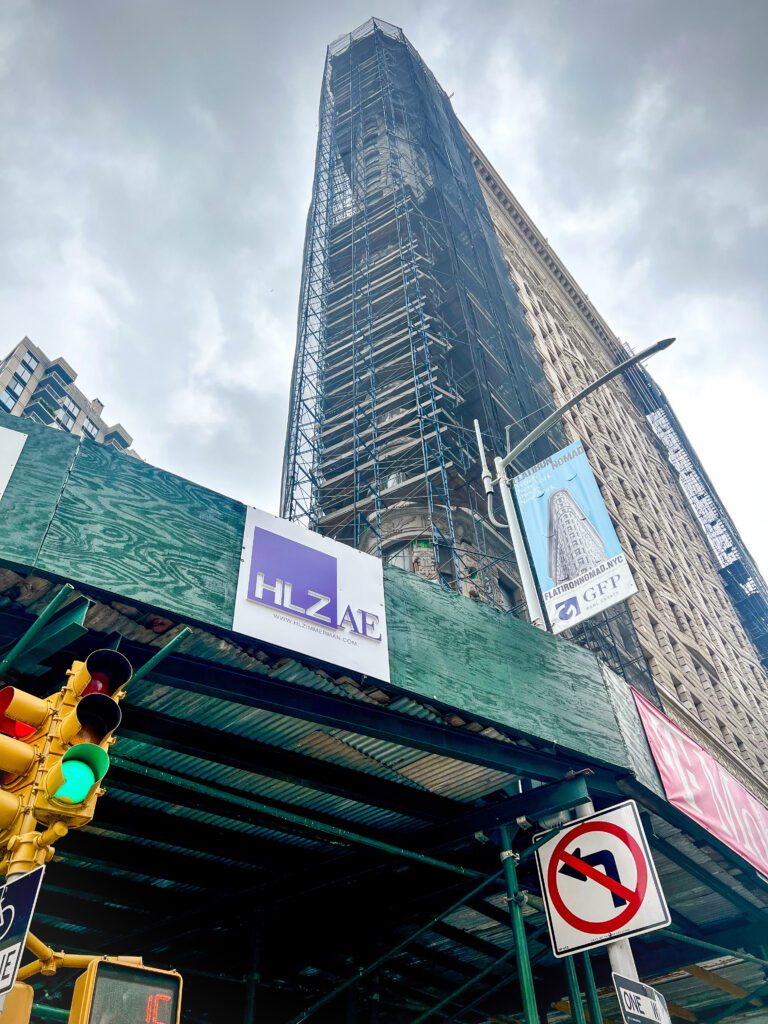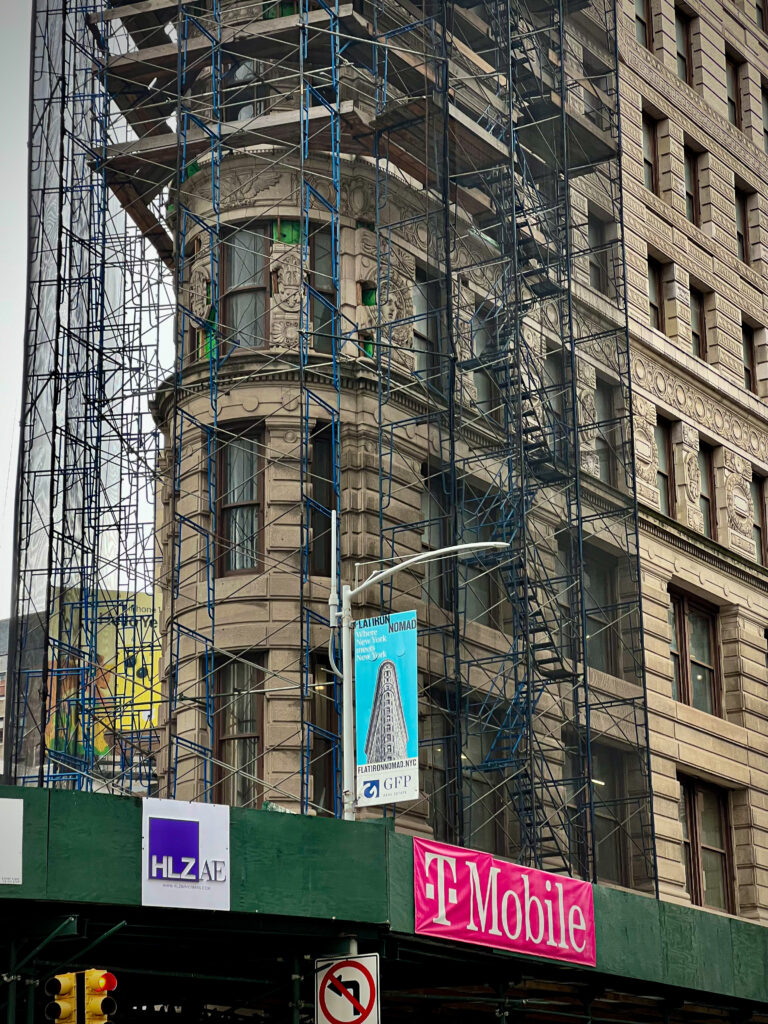Sidewalk Shed Crackdown
May 5, 2023
The Problem
NYC streets are lined with miles of sidewalk sheds to protect the public from potentially unsafe conditions on existing buildings or to protect the public while new or reparative work is underway. While some find them very helpful during heavy rain, they can be problematic for a few reasons including decreased sidewalk maintenance, poor visibility and reduced access/pedestrian traffic flow.
The Proposal
Manhattan Borough President Mark Levine and City Council Member Keith Powers released the Shed the Shed report on March 7, 2023, which outlines several proposals aimed at reducing the long-term presence of sidewalk sheds along NYC streets. The five-point plan includes the following strategies:
- Strategy 1: Provide support for buildings who need help getting work done quickly.
- Strategy 2: Reduce delays caused by permitting requirements and disputes with neighboring properties.
- Strategy 3: Hold buildings accountable for failure to complete façade work in a timely manner.
- Strategy 4: Update Local Law 11 inspection regulations and reform design standards.
- Strategy 5: Extend Local Law 11 compliance cycles in certain instances.
The details of the strategies are outlined in the report.

Our Take:
Strategy 1:
Part A – As a former coordinator of a low-interest loan program for historic properties, I know that this is a long-range strategy that would require starting up an entirely new program; one that would take years of legislation and agreement of eligibility requirements to implement. Demonstrating financial hardship can be very complicated and requires full disclosure of all financial records, something many property owners are reluctant to do. Assessment of records is subjective. For example: If a building cannot afford to do FISP repairs because they exhausted funds to install a new recreational roof terrace, would they be eligible? Aren’t you just funding their roof terrace in that instance? However, ultimately, a revolving loan fund can be a valuable self-perpetuating resource for long-term, low-income property owners who have demonstrated that they are doing everything they can to keep their property safe and need some help.
Part B – This should be tied to the above program. Most low-interest load programs typically have a component of professional services that are included with the loan package to make sure the money is being spent wisely. This is not only protects the owner from making poor decisions, it also protects the revolving loan fund from making bad loans. It provides a vital link between the professional guidance and the project by tying it to the funding. Most other properties owners should already have their own professional consultants on board to guide them..
Strategy 2:
Part A – My experience is that the LPC and DOB review process time is not significant when you place it on the timeline between when an UNSAFE FISP report is filed and when the repairs begin. More substantial delays are caused by bid negotiation and licensing negotiations with neighboring properties. I think an initiative for mediated negotiation between property owners would be very effecting in reducing project schedules.
Strategy 3:
Other than shaming the City into being a better role model for property maintenance, I think this is the least effective strategy. The penalties already in place seem to fall into two categories: Some owners can afford them and consider them the cost of doing business, and others can’t and are pushed further into debt. Careful assessment would have to be made to make sure these measures incentivize an owner to do the repairs, rather than further punishing owners who don’t have the funding in the first place. Also, it could potentially work against Strategy 1 and there would have to be coordination so the City is not imposing penalties on owners that are also getting city funding. Legally implementing emergency repairs by some kind of eminent domain by the City sounds like a very long, expensive legal process that would probably only result in spot emergency repairs to temporarily get a bridge down.
Strategy 4 & 5
I think these are excellent ideas worthy of pursuit and could have a collective effect in lowering the amount of sheds we see on the streets.

Strategy 2: This is a strategy that most design professionals would commend due to lead times we experience in getting a project off the ground and work underway. Obtaining LPC, DOB, Site Safety approvals and not to mention, securing license agreements with neighboring properties, all of these have become more cumbersome in recent years. Efforts to minimize lead times for city agency approvals and implementing an initiative for standardizing neighboring access agreements would be beneficial in expediting the work commencement date and thus the removal date of the shed.
Strategy 3: Currently, there are provisions in place to hold buildings accountable for their failure to perform façade maintenance in a timely manner but in most cases have proven to be minimally successful in accomplishing the goal at hand. While the largest landlord in NYC, “the city” fails to lead by example, the remaining building owners are subject to penalties that result in additional financial burdens or fines that are simply paid, but do not encourage building owners to expedite and/or complete the repairs in a more timely manner.
Strategy 4 & 5: I agree that both of these concepts if implemented in conjunction could reduce the number of idling sidewalk sheds in NYC.

First, for some of us older professionals, this campaign seems familiar. Over progressive administrations, there seems to be a repeated effort to “streamline and expedite” the process of building and restoring NYC Buildings. However, it worth nothing two things: 1) there have been improvements over the years with faster more efficient means of preparing and filing FISP reports, but 2) the Pandemic/Economic Shift/Supply Chain Disruption was a big jolt to the entire system from the initial professional side all the way down to the end construction side. The construction industry does not pivot quickly, and we are all still recovering from the ramifications of the past few years. It still may be years for all the dust to settle and for things to get back on track. This is to all to say that some of the sidewalk shed deluge we have today may be temporary; and may resolve itself over time on its own.
But there is always room for improvement and some of the strategies and proposals outlined in the Shed the Shed report have great merit and promise.
- The Good: Strategy 2 is something that I think many an Architect and Engineer would champion. The challenges with the Site Safety Plan system and struggles with LPC properties are worth a whole separate report of potential improvements.
- The OK: Strategy 4, Proposal 1: Drones. I am sorry to say – as someone who has been working in this arena for the past 20 years – the Drones will not save us. Ultimately, they will be a great supplemental tool for analysis – but a supplement, not a replacement. We will not do away with hands-on inspections anytime soon, nor should we in my opinion, but that is one the driving forces in the FISP inspection.
- The Missing: Partial. Shed. Removal. If the City really wants to remove sidewalk sheds from city streets, the Application and Approval process for Partial Shed Removal needs to be improved. This process allows for certification of certain segments or elevations of a building to be categorized as SAFE, such that a portion of the sidewalk shed in front of it can be removed. In existing repair programs and in new construction, there is often periods of time where the bulk of the work is completed, but the sidewalk shed must remain in place along the entire building perimeter, for only a small amount of remaining work or for a material hoist.
Overall, I applaud the efforts and advocacy of the Shed the Shed proposal and I hope for its adoption (in full on even certain portions). Those of us that work on these buildings live in the city also and we want to expedite the return of city sidewalks fully back into the public sphere as much as the rest of NYC. For over 40 years, HLZAE has supported our clients with their façade safety compliance needs.

HLZAE provides our clients with a thorough evaluation and analysis of building facades upon which you can base construction and rehabilitation decisions and maintain compliance with FISP requirements. Our goal is to consistently provide the highest quality professional architectural and engineering services for preserving a facade’s integrity while factoring in logistics and the reality of your budgets and goals. We are committed to providing professional architectural and engineering services, earning our clients’ trust not by reputation alone, but by delivering results. If your building or living space are in need of façade safety compliance services, let us help you!
Recommended Articles
Sorry, we couldn't find any posts. Please try a different search.